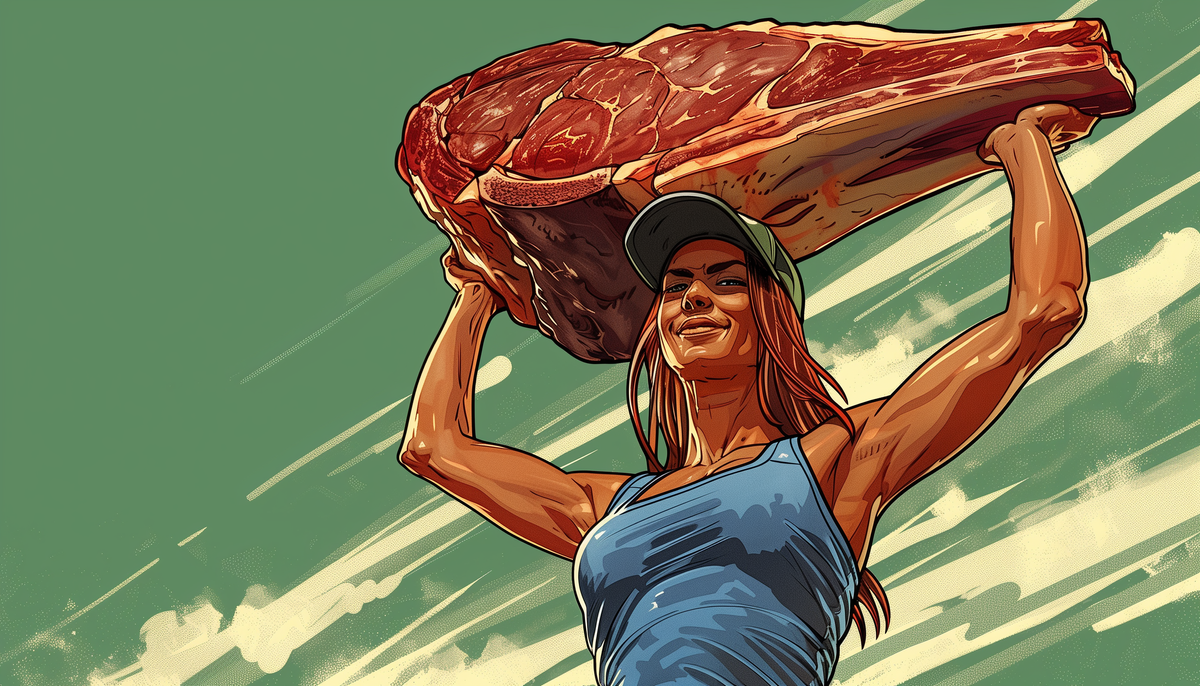25 Weight Loss Hacks That Actually Work
Our promise to you: this article is 100% free of dubious or dangerous weight loss hacks. All strategies listed are strictly science-backed.

Grab your food processor. Dump in 3 fresh chillis 🌶️, a cup of green tea, 2 tablespoons of freshly squeezed lemon juice, and a sprinkle of cinnamon. Hit blend.
Drink every morning for a week … and you’d lose weight? *bombastic side eye*
Yeahhh, no. That downright nasty concoction of ingredients is unlikely to do anything else other than inflict (unnecessary) pain on your tastebuds and gastrointestinal tract.
Fortunately, this article is 100% free of dubious and dangerous weight loss hacks like the above.
Instead, you’ll find 25 science-backed strategies designed to reduce your calorie intake and/or increase your physical activity levels relatively effortlessly — so you successfully achieve the calorie deficit necessary for weight loss.
Nutrition weight loss hacks
Let's start with some nutrition weight loss hacks! These are practical tips on eating habits that could be helpful.
Of course, we also discuss the downsides you might face with some of them.
#1: Stay well-hydrated (especially before meals)
First up on our list of weight loss hacks: drink more water before your meals so you feel full and are less likely to overeat.
OK, so it’s not exactly groundbreaking advice, but it works.
A 2010 study published in Obesity randomly assigned participants to 2 groups:
- Group 1: Hypocaloric diet + 500 ml water before each daily meal
- Group 2: Hypocaloric diet alone
After 12 weeks, the researchers found that, on average, participants in group 1 (i.e., those who drank water before their meals) lost 44% more weight, or 2 more kilograms, than those in group 2. Impressive.
To implement this weight loss hack:
Staying well-hydrated is good, but you can overdo it (aka overhydration, which could lead to water poisoning, which is about as pleasant as it sounds ☠️). While your daily fluid requirements can vary depending on factors like the environment and your physical activity levels, the general recommendation is that women should get 2.7 liters and men 3.7 liters of fluids daily.
Strive to drink 500 ml of water before your meals to temper your appetite. Assuming you eat 3 meals daily (breakfast, lunch, and dinner), that’s 1.5 liters of your daily fluid requirements. Try to distribute what’s left evenly throughout your day.
#2: Limit your consumption of ultra-processed foods
Ever said, “Just 1 more chip, and I’m done,” then found yourself at the bottom of the bag 20 minutes later?
Same. Ultra-processed foods (UPFs) are dangerous.
But just so you know, the inability to control yourself around UPFs isn’t due to a lack of discipline or willpower.
Food companies engineer UPFs with maximum addictiveness in mind — adding just the right amounts (which is often way too much) of refined sugar, fat, and sodium to keep you eating.
Worse still, UPFs are incredibly calorie-dense relative to their volume; 100 grams of potato chips pack 536 calories.
That’s more than 5-fold that of what 100 grams of baked potato contains.
This brings us to the second item on our list of weight loss hacks: limit (not eliminate!) your consumption of UPFs. Try to:
- Build your diet around whole, minimally processed foods, such as whole grains, meats, nuts, fruits, and vegetables
- Incorporate UPFs into your diet as an occasional treat
- Eat UPFs after your main meals (so you’re likely to feel satiated faster)
Gradually and sustainably reducing your consumption of UPFs should nudge your calorie balance in a desired direction over time.
#3: Follow the Mediterranean diet
Looking for more guidance on what you should or should not eat for weight loss?
Then the Mediterranean diet may be a good fit.
That’s because the diet encourages:
- Eating more whole grains, fruits, vegetables, legumes, nuts, seeds, and heart-healthy fats while
- Consuming less processed foods, added sugars, and refined grains
Which, together, are conducive to creating a calorie deficit.
Research agrees.
In this 2018 study published in Nutrition & Diabetes, researchers found that those who followed the Mediterranean diet most closely for about 12 years were less likely to become overweight or obese than those who followed the diet less closely.
Another 2020 study published in the British Journal of Nutrition found that those who reported adhering to the Mediterranean diet closely were 2x as likely to maintain their weight loss as those who did not.
There are no strict, set-in-stone rules to follow about what you can or cannot eat on the Mediterranean diet. But there are general guidelines:
- Prioritize: Vegetables, fruits, nuts, seeds, legumes, potatoes, whole grains, herbs, spices, fish, seafood, and extra virgin olive oil
- Moderate: Poultry, eggs, cheese, yogurt, and red wine
- Limit or avoid: Red meat, sugar-sweetened beverages, added sugars, processed meat, refined grains, highly processed foods (throwback to the second item on our weight loss hacks list!), beers, and liquors
#4: Give the keto diet a go
Wait. I’m giving off mixed signals here, aren’t I?
First, I tell you to try the Mediterranean diet, but now it seems like I’m saying, “Oops, no, do the ketogenic diet instead.”
Well, here’s a timely disclaimer: there’s no one “best” weight loss diet.
Calorie balance determines your weight.
Given that, the “best” diet for you will always be the one that helps you sustainably achieve and maintain a calorie deficit over the long term (we’re talking about years, not just days or weeks).
Meaning?
If you’re someone who’s never understood the appeal of carby foods — breakfast pancakes, gooey brownies, and fluffy bread — then the ketogenic diet might just be one the best weight loss hacks you could implement.
That’s because the ketogenic diet encourages you to eat fewer calories by significantly limiting the amount of carbohydrates you eat (<10% of daily calories) while ramping up the amount of fat you eat (55% to 60% of daily calories).
For most people following a “typical diet”, the macronutrient ratio distribution is:
- Carbohydrates: 45% to 65%
- Protein: 10% to 35%
- Fat: 20% to 35%
Um, but isn’t fat like 9 calories per gram?
So how would the (very) fat-rich ketogenic diet help you lose weight? Well, turns out, in most studies, keto diets decrease hunger and desire to eat. While researchers still aren’t sure why this is so, they have proposed 2 leading theories:
- Swapping out refined carbohydrates for protein increases fullness as protein is the most satiating macronutrient
- Ketone bodies — metabolites your body produces when your body burns fat for energy — may reduce appetite (although this is still an open research question)
Can’t wait to experience the weight loss benefits of the ketogenic diet?
Before you pile your plates sky-high with greasy bacon and top all dishes with a block of butter, here’s a piece of advice: prioritize heart-healthy unsaturated fat over saturated fat sources.
You may also need to be more intentional with your daily dietary fiber intake — women should try to eat at least 21 to 25 grams daily, while men should aim for 30 to 38 grams daily.
#5: Try out intermittent fasting
The Mediterranean and ketogenic diets are great weight loss hacks … only when you adhere to their dietary guidelines/rules.
And while the Mediterranean isn’t nearly as inflexible as the ketogenic diet, you’d still need to practice restraint around certain foods (e.g., poultry, cheese, and yogurt).
What if you don’t want that? What if you want to eat as you please and still lose weight?
Intermittent fasting gives you a pretty decent chance at pulling that off.
But, of course, there’s a catch.
Instead of dictating what you should or shouldn’t eat, intermittent fasting tells you when to eat.
This, in effect, (and in most cases) reduces your overall calorie intake.
To understand why, let’s look at the 3 most popular intermittent fasting methods:
Fast daily for 16 hours and restrict your daily eating window to 8 hours.
Fast every other day. There are several different versions of this method, with some allowing about 500 calories and others encouraging close to 0 calories on the fasting days.
Eat normally 5 days a week and cut back to 20% of your normal daily calorie intake (500 to 600 calories) for the other 2.
So, regardless of method, intermittent fasting should help you lose weight — as long as you don’t overcompensate for “uneaten calories” during the eating periods.
Because your calorie balance = ultimate determinant of weight.
While most people (understandably) find the 16/8 method most sustainable and easiest to stick to, feel free to experiment with different intermittent fasting methods to find one that works best for you.
#6: Include more protein sources in your meals
Remember what we said about protein under the ketogenic diet section?
Yep, it’s the most satiating macronutrient — which means eating more of it is likely to satisfy you sooner into your meal and keep you fuller for longer, resulting in a lower overall calorie intake.
Research strongly agrees that protein is one of the best weight loss hacks around.
According to a 2020 review published in the Journal of Obesity and Metabolic Syndrome, for instance, high-protein diets are beneficial in:
- Reducing body weight and enhancing body composition (by decreasing fat mass while preserving fat-free mass) and
- Preventing weight regain after weight loss
OK, I know what you’re thinking: “How much protein should I eat then?” While your ideal protein intake depends on many factors (e.g., health, body composition, and physical activity levels), a good range to hit for weight loss if you’re:
- At a healthy weight: 1.6 to 2.4 grams of protein per kilogram of body weight
- Overweight: 1.2 to 1.5 grams of protein per kilogram of body weight
An easy way to eat more protein throughout the day would be to include a protein source in every meal and/or snack you eat. Examples of good protein sources include:
White meat poultry (e.g., chicken breast), fish (e.g., salmon), pork tenderloin, lean cuts of beef, eggs, low-fat Greek yogurt, cottage cheese, and milk
Seitan, tofu, tempeh, edamame, lentils, beans, spirulina, oats, quinoa, and nuts
Psst: if you struggle to get enough protein through whole foods, protein powders could be really helpful in plugging the gap.
#7: Eat mindfully
How do you usually spend your meal times? In front of the TV? Scrolling through your TikTok feed?
If you’d like to lose weight, research suggests you might want to pay more attention to your food instead.
Why?
Turns out, eating when you’re distracted makes you eat faster, feel less satisfied, and in turn, causes you to (unknowingly) overeat!
And … bye-bye, calorie deficit.
So, how can you bring mindfulness to your meals? Here are 2 tips:
- Eat at a table: Or, at the very least, a dedicated space where you can have an uninterrupted meal. Put away your phone, iPad, laptop, TV, book, etc.
- Savor every bite: Use your senses. How does it taste? What does it smell like? What about its texture — is it crunchy, creamy, etc.? Chew slowly (FYI, experts say that, on average, you’d need 32 chews to break down food before swallowing, so do what you will with that information) and stay present.
#8: Keep the snacks out of sight
Out of sight, out of mind?
This is probably one of those “pseudo-” weight loss hacks you’d readily dismiss as useless, but guess what?
When researchers in this 2006 study published in the International Journal of Obesity investigated the relationship between an individual’s proximity to and visibility of chocolate candies 🍬 and their consumption volume over 4 weeks, they found that participants:
- Ate an average of 2.2 more candies when they were visible, and 1.8 more when they were placed closer to their desks (vs 2 meters away) and
- Consistently underestimated their daily consumption of candies that were placed near them and overestimated their consumption when the candies were further away
Meaning? When snacks are more easily accessible, you’re more likely to both over-consume and underestimate your intake.
#9: Limit the variety of snacks you have
Research shows having access to a wide variety of food (including snacks) could lead you to eat up to 23% more!
And it makes perfect sense when you think about it — there’s only so much of something you can eat continuously until you get sick/bored of it.
Compare that to when you’re able to keep things “fresh” for your tastebuds by alternating between different flavors and textures (e.g., a mouthful of smooth, slightly bitter dark chocolate tart followed by refreshing, mouth-puckering lemon ice cream; mmm 🤤).
You simply can’t help it. You’d unknowingly eat more.
So, number 9 on our list of weight loss hacks: limit the variety of snacks you have.
It might save you some money in the long term, too!
#10: Use smaller plates
We tend to eat 92% of the food we serve ourselves.
So, as you can imagine, eating from a smaller plate could help seriously cut down on the amount of food (and, thus, calories) you consume. Time to overhaul your plateware!
Don’t forget the calories you drink, too.
Drink out of tall, thin glasses instead of wide, short ones. This could reduce the amount of calorie-laden beverages (including alcohol) you drink by up to 57%.
And speaking of calorie-laden beverages … here are 3 weight loss hacks that’ll significantly reduce the number of calories you drink:
#11: “Front-load” your calories
Compared to those who use a “back-heavy” approach, individuals who eat most of their calories earlier in the day experience significantly less hunger, fewer cravings for sweets throughout the day, and higher overall energy levels.
This means they often see better weight loss results.
So, how do these findings apply to you?
Well, if you wish to lose weight without intentionally restricting your calorie intake, one of the best weight loss hacks you could use is to allocate most of your daily calories to your earlier meals (i.e., breakfast and lunch instead of dinner and supper).
#12: Plan for refeed days
Increase your calorie intake, yet still lose weight?
Mm-hmm.
Refeed days may appear as one of the most counterintuitive weight loss hacks around, but how they work is actually pretty straightforward.
And FYI, they won’t magically help you break the first law of thermodynamics — you’ll still need to eat fewer calories than your body burns to lose weight.
So … what’s all that talk about increasing your calorie intake then?
Answer: it’s only on some days.
For example, let’s say your maintenance calories are at 2,000, and you’ve determined that an appropriate and realistic deficit for you is 300 calories. I.e., you’re working with a daily calorie “budget” of 1,700.
With “refeed” days, you take a more zoomed-out perspective of your calorie intake.
Instead of managing it daily, a common approach is to manage it weekly.
Going back to our numbers, a daily calorie budget of 1,700 would translate to a weekly calorie budget of 11,900. An example of how you could distribute them would be:
- Higher calories on workout days (e.g., 1,800 calories on Mondays, Wednesdays, and Fridays)
- Lower calories on rest days (e.g., 1,625 calories on Tuesdays, Thursdays, and the weekend)
But what’s the point of doing so? When you’re technically eating the same number of calories either way? Refeed days offer 2 weight loss benefits:
Having the occasional refeed meal where you’re able to indulge a little encourages greater long-term diet adherence.
A common “side effect” of weight loss is fatigue. Naturally, that could negatively affect your drive and performance across all physical activities (in the gym or otherwise). And that’s where the additional calories on refeed days come in to save the day; they give your body a nice energy boost — making it easier for you to keep your energy expenditure levels high even as you lose weight.
A word of caution: refeed days aren’t an excuse to eat freely and over-indulge. Always remember that you’ll still need to stick to an overall calorie deficit to lose weight.
Exercise weight loss hacks
Now, let's move on to some exercise weight loss hacks.
These are tips on how you can make the most of your workouts to help with losing weight.
#13: Strength train to retain muscle mass
On a per-session basis, strength training is no match for cardio’s calorie-burning ability.

According to the 2011 Compendium of Physical Activities, the METS (metabolic equivalents) value for resistance training ranges from 3.5 to 6.0 (at the most intense), which is significantly lower than the following cardio activities:
- Bicycling, leisure, moderate effort: 8.0 METS
- Running, 9.67 km/h (6 mph): 9.8 METS
- Rope jumping, moderate pace: 11.8 METS
You’re probably asking, “Um, what’s METS?”
One MET is the energy you spend sitting at rest (i.e., your basal metabolic rate).
So, an activity with a MET value of 6.0 means you’re exerting 6x the energy than you would if you were sitting still.
OK. So, why is strength training, and not cardio, included in this list of weight loss hacks?
Answer: everyone knows that cardio is helpful for creating a calorie deficit, but very few understand the importance of preserving as much muscle mass as possible — which strength training helps with — during weight loss:
Bottom line? Do cardio and resistance training for the best, most sustainable weight loss results.
#14: Get a workout buddy
Cardio and resistance training?
If you suspect that you’ll quickly run out of motivation by the second (or fifth) workout session, get a workout buddy — or buddies — you can trust to keep you on track.
More specifically, research shows that social support could:
- Enhance your adherence to your exercise routine
- Boost your workout effort (increasing your calorie expenditure)
- Increase your chances of maintaining your weight loss results over the long term
#15: Stop switching workouts
It’s fine to explore different cardio activities.
But when exercising in the gym, it’s best to follow a fixed, structured routine instead of simply “cooking up” a random workout session as you go.

As mentioned in the strength training weight loss hack, maintaining as much muscle mass as you can in a calorie deficit is key for long-term weight loss success.
For optimal growth, a muscle group needs to be trained:
- 2 to 3 times weekly
- Close to failure
- With progressive overload (i.e., continuously challenged)
And chances are, picking random exercises at the gym to do — “Oh, that hack squat machine looks great! Let’s do that! Ooooh, then let’s do lateral raises!” — just wouldn’t create the right conditions for optimal muscle maintenance and/or growth.
This begs the question: how should you structure your workout routine, then?
Well, it depends on your lifting experience, preferences, injury history, and physique goals. And that's a whole-ass discussion for another time.
#16: Implement dietary and exercise changes simultaneously
This may sound like a duh, but it’s always nice to know this has been backed up by research.
Research shows making positive changes to your diet and exercise at the same time leads to better adherence than tackling either of them one after another.
Lifestyle weight loss hacks
We've discussed tips on nutrition and exercise. But let's not forget that our daily habits can make a huge difference on our weight loss journey too.
That's why these lifestyle weight loss hacks are worth paying attention to.
#17: Spend more time walking
Intentional, planned physical activity (e.g., going to the gym and exploring hiking trails) isn’t the only way for you to increase your energy expenditure.
There’s also something called non-exercise activity thermogenesis or NEAT, the energy you burn for everything you do, excluding sleeping, eating, or sports-like exercise.
For example: walking — to work, the grocery store, or dog walking 🐕.
But you may be wondering, “How big of a difference could walking possibly make for weight loss?”
A 2017 study published in The Journal of Nutrition says it’s more than you might think. The researchers randomly assigned participants to 2 groups:
- Low-calorie diet
- Low-calorie diet + 2,000 to 3,000 added steps daily
After 12 weeks, those in the low-calorie diet + added steps group lost around 1.36 kg more fat than those in the low-calorie diet.
Of course, this isn’t to say that you should only aim to clock 2,000 to 3,000 steps daily.
A good guideline for most adults is 10,000 steps daily.
To put that into perspective, assuming you walk at the average pace of 4.8 km/h (3 mph), it’ll take you 1 hour 40 minutes of walking to hit 10,000 steps.
Wait a minute. That’s starting to sound suspiciously like planned, intentional physical activity.
Well, the idea here is for you to break the walking up into short, manageable chunks throughout your day, for example:
- Walk the doggo in the morning: 20 minutes
- Morning commute to the office: 10 minutes
- Journey to and fro your usual lunch spot with colleagues: 30 minutes
- Afternoon break: 10 minutes
- Evening commute back home: 10 minutes
- Walk the doggo again in the evening: 20 minutes
Not as hard as it originally seemed, right?
#18: Clock enough sleep every night
Move more. Eat less. All the weight loss hacks covered thus far require some degree of effort.
So, you might find this hack a breath of much-needed fresh air: get 7 to 9 hours of good-quality sleep nightly.
And that’s because sleep deprivation is linked to:
- Decreased exercise stamina and quicker exhaustion
- Fatigue (which means you won’t move about as much — good luck hitting those recommended 10,000 daily steps!)
- Poor appetite regulation; studies show that even a single night of poor sleep could negatively affect your appetite hormones (e.g., ghrelin and leptin), leading to increased hunger and food cravings, especially for those sugar-, fat-, and calorie-packed ultra-processed foods
The result?
Energy expenditure goes down while calorie consumption goes up: a double whammy for your weight loss aspirations.
And for those of you who find sleep a frustrating, toss-and-turn affair:
Keep your bedroom cool (15.6°C to 20°C or 60°F to 68°F), quiet, and dark. Limit your exposure to blue-light-emitting electronic screens before bedtime. And stick to a consistent sleep-wake schedule — yes, even on the weekends and off days!
The mean half-life (the time it takes to reduce by half) of caffeine is about 5 hours. In other words, multiple doses of caffeine, even supposedly “small, negligible” doses, can build up in your bloodstream and make bedtime a forced, fruitless sheep-counting event.
A meta-regression model in this 2023 meta-analysis published in Sleep Medicine Reviews agrees, suggesting that you should tweak your caffeine cut-off time according to your dosage:
217.5 mg (pre-workout supplement): 13 hours before bed
107 mg (coffee): 9 hours before bed
47 mg (black tea): Small caffeine doses appear to minimally affect sleep. But, once again, it’s crucial to remember that multiple small doses can quickly snowball into serious sleep-disrupting concentrations.
The former could worsen sleep by interfering with digestion and increasing the risk of heartburn. As for the latter? While it tends to promote quicker sleep onset, alcohol is known to suppress REM sleep, decreasing overall sleep quality. The result is shorter sleep duration and more sleep disruptions.
#19: Go easy on the alcohol
Another reason to reduce your alcohol consumption? It’s bursting with calories.
As mentioned earlier (under #11 of our weight loss hacks), alcohol packs 7 calories per gram. In fact, here’s the calorie count for a single serving of some of the most popular alcoholic beverages available:
- Craft beer: 170 to 350 calories
- Chocolate martini: 418 calories
- Tequila sunrise: 232 calories
- Mai Tai: 306 calories
- Gin (94 proof): 116 calories
So, imaginably, the calories can quickly add up on a night’s out, especially if you’re also indulging in deep-fried bar food, such as onion rings and mozzarella sticks.
This highlights why it’s so important for you to practice drinking in moderation; a few tips:
- Set a hard limit: E.g., “I will only have 4 alcoholic drinks weekly.”
- Alternate with non-alcoholic drinks: If it’s a social night out and the thought of being the only one nursing plain ol’ water or kiddish mocktails makes you shudder, go for no-ABV wine, spirits, and beers. They often look and feel like the real thing — except often at half the calories. What could be sweeter than that?
- Suggest alcohol-free activities: Spending quality time with friends, family, and loved ones doesn’t necessitate alcohol consumption. Sign up for a craft workshop. Explore a new hiking trail. The alcohol-free possibilities are endless.
#20: Beware of health halos
A chocolate bar and a protein bar — quick, which contains more calories?
If you said “chocolate bar” without hesitation, you’ve fallen victim to something called the “health halo effect”.
It's a cognitive bias where you overestimate the healthfulness of an item based on a single characteristic (e.g., protein bars are full of protein, so they must be healthier and lower in calories than chocolate bars).
And FYI, a 60-gram serving of:
- Rise Bar’s Almond Honey Protein bar: 280 calories
- Cadbury’s Dairy Milk Slices (Vanilla Passionfruit): 270 calories (🤪)
The health halo effect is particularly dangerous because it essentially encourages you to eat more than you otherwise would have because you feel less guilty.
(You’re more likely to eat 2 protein bars because, #health, instead of 2 chocolate bars.)
Now that you’re aware of the health halo effect … prevent it from derailing your weight loss efforts by scrutinizing the nutrition label of every supposedly “low-calorie” or “healthy” food.
Know the exact number of calories you’re putting into your mouth.
#21: Take the time to meal prep
Compared to a home-cooked meal, how many more calories do you think you end up eating at a fast-food or full-service restaurant?
Answer: 190 and 187 calories, respectively.
Those are figures that could make or break your calorie deficit.
So, one of the top weight loss hacks that’ll immediately come to mind is this: “Meal prep more often!” This way, you have better control over the number of calories you’re consuming in every meal.
Ah, we can hear you grumbling, “Who has the time to meal prep?!”
To that, we say, note the keywords: more often.
You don’t have to meal prep all your meals.
Even replacing a takeout meal with a meal-prepped one 1-3x a week could be enough to see results. Every little bit (read: calorie) counts.
#22: Take a chill pill
Stress promotes weight gain by:
- Flooding your body with cortisol, the stress hormone, which makes you crave “comfort foods” (often sugary, fatty, calorie-dense foods such as glazed donuts and Mac and Cheese) and lowers your metabolism
- Disrupting healthy sleep patterns — throwing your appetite-regulating hormones out of whack and increasing the chances that you’d skip out on your exercise routine
Hmm. OK. But let’s be honest, there’s no “on-off” switch you could toggle to get rid of your stress.
Well, that’s why the weight loss hack here is to find ways to manage (i.e., lower as much as possible) your stress instead of eliminating it.
Stress management strategies you could try include deep breathing, meditation, aromatherapy, and good old exercise.
#23: Lose weight slowly
Fast and furious is not the way to go when losing weight.
Research consistently shows that individuals who lose weight gradually are more likely to keep it off long-term. Why, though?
There are 2 primary reasons:
The more aggressive your calorie deficit, the more prone your body is to losing muscle mass, which is crucial for appetite regulation. In other words: the faster you lose weight initially, the hungrier you’ll get down the road. Good luck with sticking to a calorie deficit, then.
Creating an aggressive calorie deficit usually requires pairing very few calories with loads of exercise. How long can you sustain that kind of lifestyle? Once you revert to your old eating and exercise habits, your weight will quickly rebound.
But how would you know what’s considered “too aggressive”?
A 2014 review published in the Journal of the International Society of Sports Nutrition proposed that the sweet spot weight loss rate that’ll help you maximize fat loss while minimizing muscle mass loss is this: 0.7% body weight per week.
For most people, this equates to a 15% to 25% calorie deficit.
(I.e., if maintenance calories = 2,000, your target calories would range from 1,500 to 1,785 calories daily.)
#24: Don’t deprive yourself
And, on that note, don’t deprive yourself of all your favorite foods.
In most cases, sticking to a moderate calorie deficit would afford you some “room” to include foods like pizzas, burgers, croissants, ice cream, and [insert your favorite indulgences].
Consuming these foods in moderation is great for your emotional health and goes a long way to encouraging diet adherence — the most important factor for long-term weight loss management.
Who would have guessed? Turns out, you can have your cake and eat it, too! 🎂
#25: Consistency is key
If you’ve made it allll the way down here, then you must have realized a recurring theme throughout the weight loss hacks.
Consistency.
And that’s because … interestingly, research shows that no matter the specific lifestyle change you make to lose weight — diet: from the keto diet to intermittent fasting; exercise: from bicycling to HIIT classes — if you do it consistently, you’ll see greater success with long-term weight loss.
You don’t have to implement all the weight loss hacks
Alright, that’s all the weight loss hacks we have (25! Phew!)
On a parting note, please rest assured that:
You don’t have to implement all of them to see results.
In fact, some are clearly at odds with others (e.g., trying the keto diet means forgoing the Mediterranean diet and vice versa).
So just pick the ones aligned with your lifestyle and preferences, and stay consistent.





